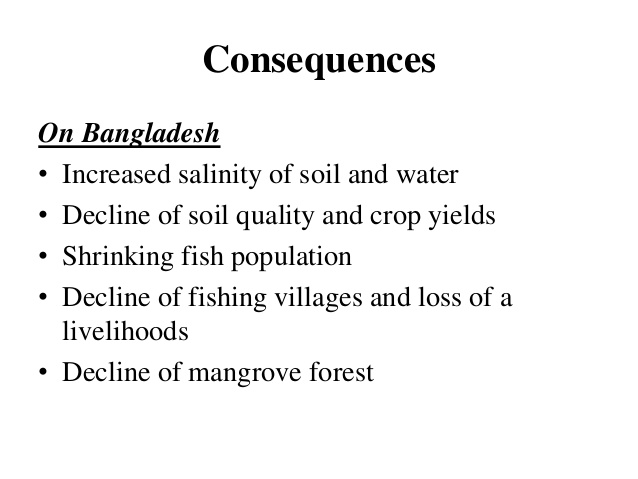Farakka barrage, adverse effects on Bangladesh and India
Farakka Barrage is a barrage across the Ganges River, located in Murshidabad district in the Indian state of West Bengal, roughly 16.5 kilometres (10.3 mi) from the border with Bangladesh near Shibganj. Farakka Barrage Township is located in Farakka (community development block) in Murshidabad district. Construction was started in 1961 and completed in 1975 at a cost of ₹156.49 crore(US$23 million). Operations began on 21 April 1975. The barrage is about 2,240 metres (7,350 ft) long.[1] The Feeder Canal (Farakka)from the barrage to the Bhagirathi-Hooghly River is about 25 miles (40 km) long.
The Ganges Treaty between India and Bangladesh is an agreement to share surface waters at the Farakka Barrage near their mutual border.Yet, the conflicts and crises between India and Bangladesh arising out of this Treaty are not limited to simply reduced flows below 50,000 cusecs. The issue of flooding is of particular concern to Bangladesh. As a deltaic floodplain, Bangladesh already faces even greater risk of flooding than drought. Because the Ganga Treaty allows India to withdraw a maximum of 40,000 cusecs irrespective of the overall flow of the river, when the flow reaches 2,000,000 cusecs – the point at which the river breaches its banks – there is no recourse in the Treaty for flood alleviation. The flood risk is compounded by the rapid rise in silt deposition rates occurring since the Farakka Barrage was erected.
Farakka Barrage is a barrage across the Ganges River, located in Murshidabad district in the Indian state of West Bengal, roughly 16.5 kilometres (10.3 mi) from the border with Bangladesh near Shibganj. Farakka Barrage Township is located in Farakka (community development block) in Murshidabad district. Construction was started in 1961 and completed in 1975 at a cost of ₹156.49 crore(US$23 million). Operations began on 21 April 1975. The barrage is about 2,240 metres (7,350 ft) long.[1] The Feeder Canal (Farakka)from the barrage to the Bhagirathi-Hooghly River is about 25 miles (40 km) long.
EFFECT ON BIHAR, INDIA
The Nitish Kumar government(BIHAR, INDIA) has held the Farakka barrage in West Bengal responsible for heavy floods in Bihar and asked the Centre to decommission it to desilt the heavily loaded upstream of the Ganga river.
The state has made the recommendation, observing that the dam is the “genesis of severe floods” and responsible for “alarming” silt increase upstream.
‘Severe harm’
The Nitish Kumar dispensation has made the demand before an experts’ committee formed by the Centre to work out guidelines for desilting the Ganga following last year’s devastating floods, sources told PTI.
The Farakka barrage was constructed in the early 60s with the main purpose of helping flush out sediment deposition from Kolkata Port, besides addressing drinking water requirement in West Bengal.
“The barrage is the genesis of severe flood consequences and responsible for progressive silt increase in the upstream of the Ganga between Patna and Bhagalpur (in Bihar),” the state government has told the committee, according to sources.
“Decommissioning the barrage will help automatically desilt the heavily loaded upstream, allowing silt to move to deltas before the sea,” it said.
Such a move, the state has said, will further help in restoration of deltas and its ecosystem, which is also getting adversely affected by this barrage.
To buttress its point, the state government has referred to Kolkata Port Trust’s data, which suggests that silt dredging at the port has increased from 6.40 million cubic metres annually from pre-Farakka days to four times, i.e. at 21.88 MCM annually, during 2003. The dam became operational in 1975.
“So the barrage is of no help... Functioning of the barrage is itself giving rise to flooding,” the state has said in its submission.
‘Threat to aquatic species’
Among others, the government has blamed the barrage also for constricting “severely” movement of habitations and normal cycle of aquatic species, mainly fishes like Ilish (Hilsa) and Chingri.
“Their migration, reproductive cycle and survival have been affected to the extent of being extinct. It also has adverse impact on dolphin sanctuary at Bhagalpur. The number of dolphins there is decreasing, which can be estimated from their frequency of sighting,” the sources said.
The state government has also recommended to the panel to come up with ‘National Silt Policy’ to address the problem. Bihar faced one of its worst floods as the Ganga swelled in August last year, claiming lives of over 20 persons and affecting 20 lakh people.(Published on February 19, 2017,THE HINDU)





